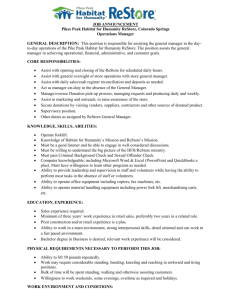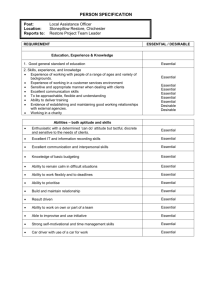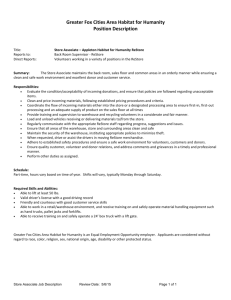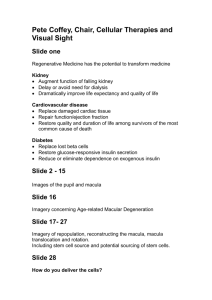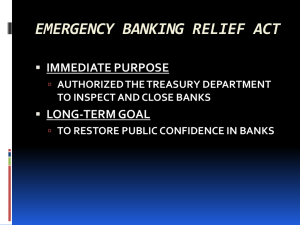q/restore - QSA Enterprises
advertisement
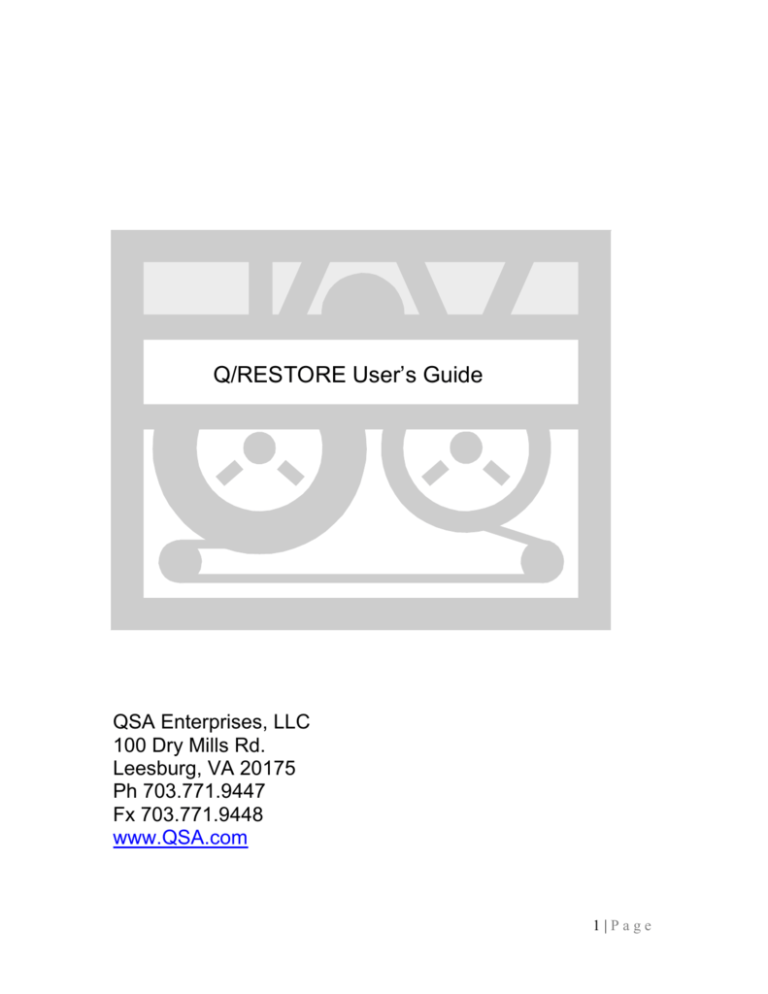
Q/RESTORE User’s Guide QSA Enterprises, LLC 100 Dry Mills Rd. Leesburg, VA 20175 Ph 703.771.9447 Fx 703.771.9448 www.QSA.com 1|Page Table of Contents Q/RESTORE Overview Q/RESTORE Installation Q/Restore Stand-Alone Q/Restore for Q/Tos Q/Restore for TMF Q/Restore for DSM/TC Q/RESTORE Operation Q/Restore Stand-Alone Q/Restore for Q/Tos Q/Restore for TMF Q/Restore for DSM/TC Contact QSA, Q/RESTORE, and Q/TOS are all trademarks of QSA Enterprises, LLC NonStop, TMF, DSM/TC, BACKUP, and RESTORE are all trademarks of Hewlett Packard. 2|Page Q/RESTORE Overview Q/RESTORE provides fast access to BACKUP tape data and is used as an accelerator for the HP NonStop RESTORE product. Q/RESTORE is a tape server that scans the tape for the exact location of the requested fileset(s) and only sends the necessary data to the RESTORE process. Listing Source Restore Process Q/Restore Process Tape Q/Restore gets its knowledge of the backup tape set from a listing source. The listing source is different for each version of Q/Restore. The stand-alone version uses the backup listing stored in the spooler. The other versions use data stored in various databases. Q/Restore runs in several different environments and because of the unique requirements presented by those environments, there is a different program object file for each one. All program versions except the TMF version use the same tape scan engine. The TMF version is exclusive because TMF uses a different tape record format than BACKUP does. 3|Page The versions of Q/Restore are: Q/Restore Version Q/Restore Program Name HP Nonstop Environment Listing Source Stand-Alone Q/Tos TMF DSM/TC QrestSA Qrestore QrestTMF QrestDT Guardian QSA Q/Tos TMF DSM/TC Backup Listing (spooler) Q/Tos database TMF database DSM/TC database The individual versions of Q/Restore are also started differently from one another. The Stand-Alone version is started from a TACL prompt, the same as guardian restore. The Q/Tos version is started from a QTOSCOM prompt. The TMF and DSM/TC versions are integrated into those environments and are started from TMFCOM and MEDIACOM prompts with their respective RECOVER command. Q/Restore works by eliminating unnecessary tape reads. So a tape with many small files will produce a better result (compared to a non-accelerated restore) than a tape utilizing the same amount of tape, but with fewer larger files. However, the time saving in either case is substantial. Also, the way the file list is constructed can affect the elapsed time of the restore. A large number of NOT files in the command line will cause unnecessary reads. And, of course, if all of the files of a tape are restored Q/Restore will show no time benefit since all reads are necessary. 4|Page Q/RESTORE Installation All versions IXF or FTP the archived (PAK) file to your system and place the contents into $Vol.Subvol.qrestsa (use binary). FUP alter <archive file>, code 700 Run <archive file>,*.*.*,listall,open,tapedate,vol $vol.subvol (if RUN doesn’t work, try “UNPAK”) The QRESTORE files will now exist in the $vol.subvol location. Stand-Alone version Move QRESTSA to the $SYSTEM.SYSTEM subvolume or anywhere the system administrator prefers. QRESTSA can be run from any disk location on the HP Nonstop. Q/Tos version Move the QRESTORE program to the Q/Tos object subvolume. You should have already upgraded your Q/Tos environment to the appropriate release level for Q/Tos (4.10 minimum) to support the QRESTORE command. 5|Page TMF version 1. Move the three files (qresttmf, qrtcnfg, qlibrt) to a separate subvolume. The name of the subvolume is unimportant. (Example: $data.qresttmf) 2. Edit the qrtcnfg file. This is where QRestTMF gets its run-time information. Leave the DEBUG and TRACE flags to OFF. With the TRACE flag set to off there is no reason to alter the TRACE-LOCATION filename. The following entries should be verified: TMFDR-LOCATION REPORT-LOCATION TMFCONFIG-LOCATION the location of the TMFDR file. $SYSTEM.SYSxx.TMFDR the spooler location where QRESTTMF will send its output. If this is blank, no output will be produced. the location of the FRLIST file. $SYSTEM.ZTMFCONF.FRLIST 3. Make sure no occurrences of TMFDR are running. STATUS *,PROG $*.*.TMFDR 4. Run $system.sys##.tmfdr/lib qlibrt/ There will be errors. Ignore them. 5. tacl 15> tmfcom TMFCOM - T8652G08 - (12AUG2005 - TMF) (C)2005 Hewlett-Packard Development Company, L.P. 6. TMF 1> alter process (onlinerestore,auditrestore),programfiles $vol.subvol.qresttmf To uninstall: 1. run $system.sys##.tmfdr/lib/ Again, there will be errors. Again, ignore them. 2. tacl 15> tmfcom TMFCOM - T8652G08 - (12AUG2005 - TMF) (C)2005 Hewlett-Packard Development Company, L.P. 3. TMF 1> alter process (onlinerestore,auditrestore),programfiles $system.sys##.tmfdr 6|Page DSM/TC version 1. Make sure no occurrences of MEDIASRV are running. STATUS *,PROG $*.*.MEDIASRV 2. Run $system.sys##.mediasrv/lib qlibrd/ <break> STOP 3. Move the QRESTDT program to the same volume as the guardian RESTORE is. To uninstall: 1. Make sure no occurrences of MEDIASRV are running. STATUS *,PROG $*.*.MEDIASRV 2. run $system.sys##.mediasrv/lib/ <break> STOP 7|Page Q/RESTORE Operation Stand-Alone version Starting Q/RESTORE is similar in syntax to that of the HP NonStop RESTORE program. The same options and parameters are valid with Q/Restore as with Restore. But because Q/RESTORE has to get information from the backup listing there has to be a way to pass the listing location information to the Q/RESTORE program; this is done by placing the spooler supervisor name and job number of the listing within the command string. This is done by encasing this information within the “<” and “>” characters (i.e. <$SPLS.#712> ). This is imbedded within the run parameters whether on the command line or within an IN file, and can be anywhere within the restore options data. This does not add any commas to the syntax. The only other requirements are that the process MUST be named and the tape set used in the BACKUP must be labeled tapes. Q/RESTORE can be used with both Class Tapecatalog and Tape Defines. i.e. delete define =tape add define =tape,class tapecatalog, catalog on,& use in,filecat \qsa.qsafcat,& labels backup,& volcat \QSA.qsavcat,volume(SP0027,SP0004),device \qsadev.$dat,fileid catlog The Q/RESTORE program is called qrestsa Examples: 1. Restore a file from listing stored in spool supervisor $SPLS job 712 from a command line Run qrestsa/out$s.#rest.out,name/=tape,$data.qsa.dump<$SPLS.#712>,listall,open 2. Restore files from listing stored in spool supervisor $SPLS job 712 using an in file Run qrestsa/out$s.#rest.out,in infil,name/ INFIL contents $tape, ($data.qsa.dump,$obj.qsa.test), listall, open 8|Page Q/Tos version Starting a Q/RESTORE through Q/TOS is syntactically the same as starting a RESTORE process, except the command is QRESTORE instead of RESTORE. When the QRESTORE command is executed, a qrestore process is started. The qrestore process then starts a restore process, thus becoming the central hub for communication between the restore process, the tape system and Q/TOS. The Q/RESTORE for Q/TOS program is called qrestore. Examples: 1. Restore files from a QTOSCOM prompt. Qtoscom> Qrestore (test(1)) $tape, (system.qtosobj.*,$prod.qsparc.*), listall, open 2. Restore files from a restore file created by the FILE FINDER function of QTOSDB. Qtoscom> Qrestore $tape,file,listall,open 3. Restore files from an input file. Qtoscom>Qrestore(test(1))/out$s.#rest.out,in infil/ INFIL contents $tape, ($data.qsa.dump,$obj.qsa.test), listall, open 9|Page TMF version Q/Restore works within the TMF environment and is completely transparent to the user. Files are restored via the RECOVER FILES command in TMFCOM. Example: ~ recover file $system.subvol.fn,fromarchive DSM/TC version Q/Restore works within the DSM/TC environment and is completely transparent to the user. Files are restored via the RECOVER DISKFILES command in MEDIACOM. Example: MC> recover diskfile $system.subvol.fn,tapefile catlog 10 | P a g e Contact QSA Enterprises, LLC 100 Dry Mill Rd. Leesburg, VA 20175 Phone 703.771.9447 Fax 703.771.9448 support@qsa.com www.QSA.com 11 | P a g e
